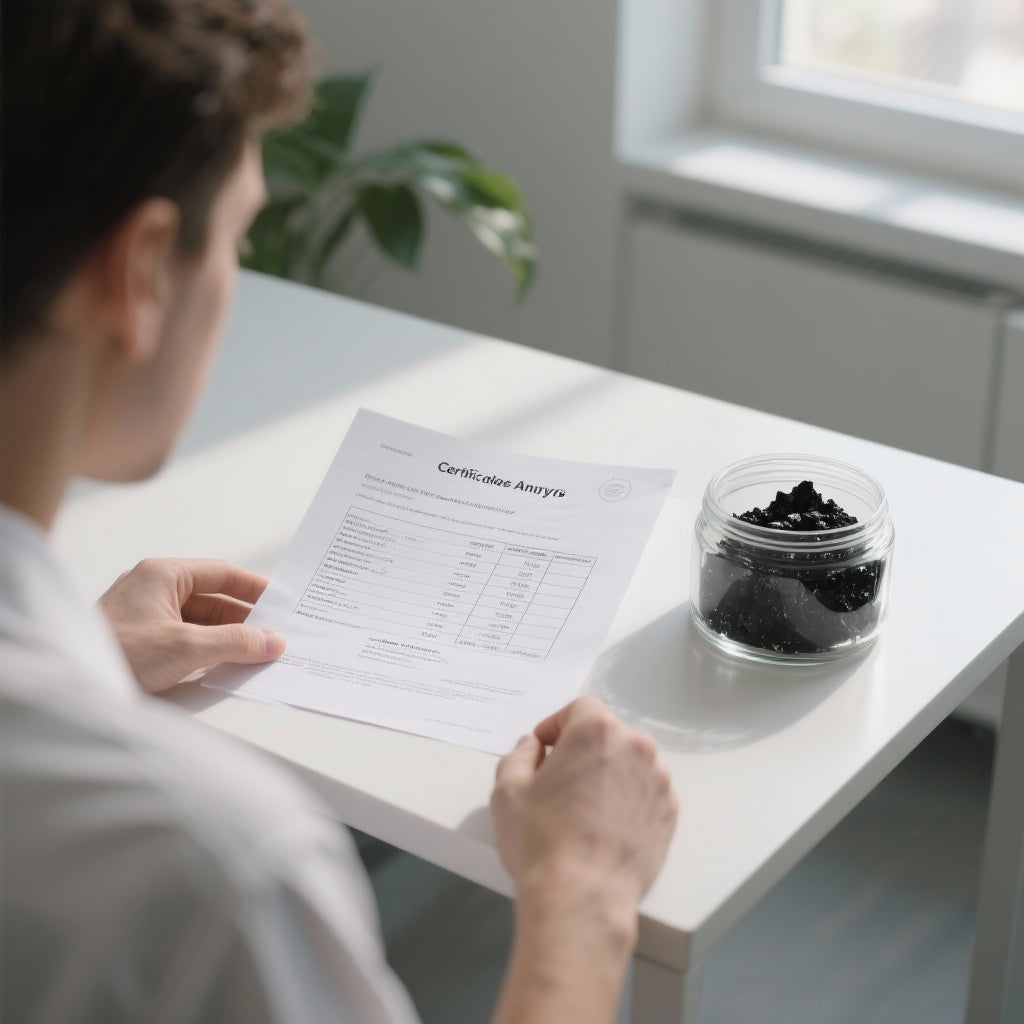How to interpret Shilajit analysis certificates: A guide for informed consumers
You've taken the first step by choosing to incorporate Shilajit, this treasure of nature, into your wellness routine. But faced with a market flooded with options, a crucial question remains: is your Shilajit truly pure, safe, and potent? The answer isn't on the label, but in a document that's often intimidating: the Certificate of Analysis (CoA).
This guide is designed to transform you into an informed consumer. We'll demystify this technical document, line by line, empowering you to verify the quality of what you consume. Say goodbye to doubt, and hello to trust and transparency.
What is a Certificate of Analysis (CoA) and why is it crucial?
Think of the Certificate of Authenticity (CoA) as your Shilajit's passport. It's an official document, issued by an independent third-party laboratory, that verifies the composition, purity, and safety of a specific batch of product. Without this document, you're operating blindly, relying solely on the seller's promises.
The guarantee of an impartial analysis
The most important aspect of a credible Certificate of Analysis (CoA) is that it must come from a third-party laboratory . This ensures that the results are not biased by the manufacturer or seller. An internal CoA, while sometimes informative, does not offer the same level of assurance. Always look for the name and contact information of a recognized laboratory on the document.
"A Shilajit sold without a recent and complete third-party Certificate of Analysis is a red flag. Transparency is not an option, it is an obligation to guarantee consumer safety."
Every consumer should demand this level of proof before making a purchase. It's your right to know exactly what's in the product you're ingesting. For more information on the fundamentals of wellness, explore our main blog .
Heavy metal analysis: Your top priority
Shilajit is a biomineral resin that seeps from mountain rocks. By its very nature, it can absorb elements from its environment, including potentially harmful heavy metals. Therefore, rigorous analysis is essential.
The four suspects to watch
The CoA must absolutely test for the presence of the four most dangerous heavy metals for human health:
- Lead (Pb): Neurotoxic, even in small doses.
- Arsenic (As): Known carcinogen.
- Cadmium (Cd): Harmful to the kidneys and bones.
- Mercury (Hg): Extremely toxic to the nervous system.
How to read and interpret the results
Results are usually expressed in ppm (parts per million) or µg/g (micrograms per gram) . The goal is to see the lowest possible values. Ideally, you will look for terms like "ND" (Not Detected) or "< LQD" (Below the Limit of Quantification), which means the concentration is so low that it cannot be measured by laboratory instruments.
Each country has its own regulatory limits, but generally, levels below 1 ppm for lead and arsenic, and much lower for cadmium and mercury, are considered safe. A high-quality product will show results significantly below these thresholds.
Fulvic acid and minerals: The heart of Shilajit's power
Beyond safety, the CoA also confirms the potency of your Shilajit. The main active compound, responsible for most of its benefits, is fulvic acid . It acts as a carrier, improving the bioavailability of the more than 84 minerals and trace elements present in Shilajit.
What percentage of fulvic acid should I be looking for?
High-quality Shilajit typically contains over 50% fulvic acid. Some premium products can even reach 60% to 70%. If the Certificate of Authenticity (CoA) does not specify the percentage of fulvic acid, or if it is very low, the potency and effectiveness of the product are questionable. This is a key indicator of the quality of the raw material and the purification process.
The interaction between fulvic acid and minerals is a powerful synergy. One cannot exist without the other. A good CoA should ideally also list the concentration of key minerals such as iron, magnesium, or zinc, although this is less common.
For ideas on how to incorporate Shilajit into a healthy diet, visit our recipe blog .
Microbiological testing: The guarantee of a safe product
Properly purified Shilajit must be free of microbiological contaminants. The Certificate of Authenticity (CoA) must include a section dedicated to these tests to ensure the product does not harbor harmful bacteria, yeasts, or molds.
Key checkpoints:
- Total number of aerobic bacteria: Indicates the overall cleanliness of the product. A low value is desirable.
- Yeast and mold: Should be very low or absent.
- Specific pathogens: The test must confirm the absence (marked as "Absent" or "Negative") of dangerous bacteria such as E. coli , Salmonella and Staphylococcus aureus .
These results are often expressed in CFU/g (Colony Forming Units per gram). The presence of any of these pathogens renders the product unfit for consumption. Do not compromise on this.
The details that make the difference: Final checks
Before giving your final approval, review some administrative details on the CoA that demonstrate the professionalism and traceability of the product.
- Batch Number: The CoA must match the batch number printed on your Shilajit jar. This proves that the test applies to the product you are holding.
- Date of analysis: A recent test (generally less than a year old) is a guarantee of relevance.
- Laboratory name and accreditation: Look for an accreditation such as ISO/IEC 17025. This is the international standard for the competence of testing and calibration laboratories.
These elements, while seemingly secondary, build a complete picture of the brand's transparency and commitment to quality. They reflect a lifestyle focused on awareness and quality.
Conclusion: Your power as a consumer
You now have the tools to decipher any Shilajit Certificate of Analysis. In short, your checklist is simple: verify low levels of heavy metals, a high fulvic acid content, the absence of microbiological contaminants, and that the batch information matches. Never hesitate to ask a seller for a CoA before buying.
By taking a few minutes to perform these checks, you not only ensure you're investing in an effective product, but more importantly, you protect your health. This is the final step to consuming Shilajit with complete confidence and peace of mind.
Have you ever encountered a difficult-to-understand CoA? Share your experience in the comments!











